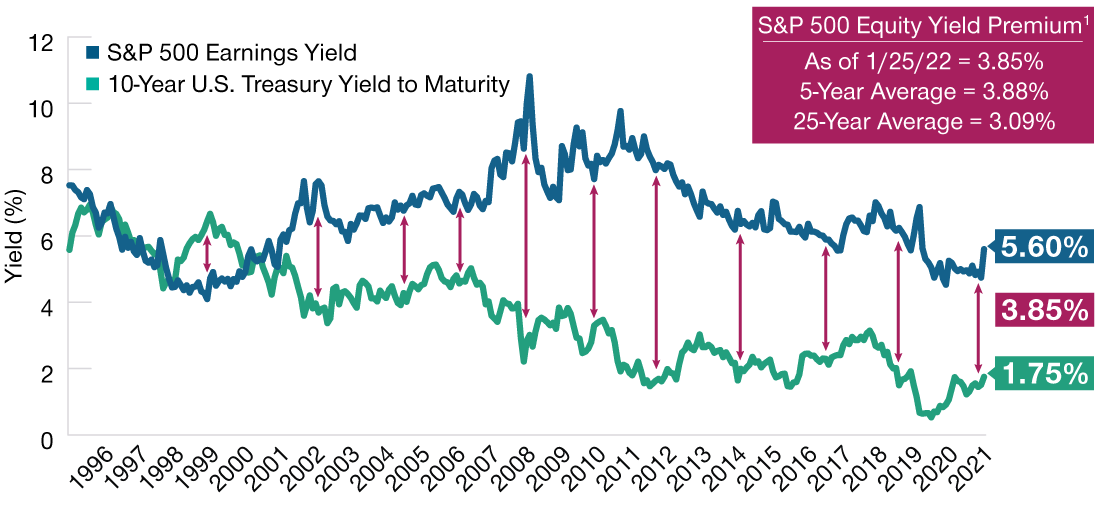- Asset Allocation Insights
- What Pivot to Higher Rates May Mean for Stocks
- 2022-02-08 20:46
- Key Insights
-
- Global equity markets sold off in the opening weeks of 2022 as investors weighed the potential impact of higher interest rates on their stock portfolios.
- In an effort to manage near‑term risks, the Asset Allocation Committee currently is underweight equities, tilting away from areas vulnerable to rising rates.
After maintaining a dovish position for most of 2021, the U.S. Federal Reserve (Fed) recently pivoted to a notably hawkish stance. As a result, interest rates are on the rise, which, in part, has driven recent equity market volatility.
While the Fed is still in the very early stages of a hiking cycle, we believe a review of yield premiums across a range of past economic cycles could provide useful insights for investors concerned about the potential impact of higher rates on their portfolios.
By comparing the current yield to maturity of the 10‑year U.S. Treasury note to the earnings yield on the S&P 500 Index—earnings per share divided by price—investors can measure the premium that equities have historically offered over bonds. While this premium was fairly consistent over the five years ended January 25, 2022, it varied widely over the last 25 years (Fig. 1) and was significantly lower prior to the 2008 global financial crisis.
The derived equity premium can be used to estimate the potential impact of higher interest rates on valuations and even on stock prices. For example, if interest rates were to move higher while the equity yield premium remained relatively unchanged—as it has over the past five years—our analysis suggests that stock prices could hypothetically fall further, even after the recent meaningful sell‑off. However, if we assume a yield premium equal to the 25‑year average, the impact of rate increases appears muted.
In our view, further interest rate increases could be a headwind for equities—at least over the near term—but the overall impact could be somewhat mitigated as investors adjust their equity yield premium expectations. In an effort to manage the near‑term risks, our Asset Allocation Committee has an underweight tactical position in equities, tilting away from areas vulnerable to rising rates. Within equities, the committee currently is underweight growth and U.S. stocks relative to value and other global regions, respectively.
Equity Yield Premium Averaged Higher in Last Five Years
(Fig. 1) Rising interest rates could bring lower equity yield premiums

Based on historical data for the 25 years ended January 25, 2022.
Past performance is not a reliable indicator of future performance.
1 Equity yield premium = S&P 500 Index earnings yield (earnings/price) - Yield to maturity of U.S. 10-year Treasury note.
Sources: Bloomberg Finance L.P. and S&P (see Additional Disclosures).
-
Additional Disclosures
Copyright © 2022, S&P Global Market Intelligence (and its affiliates, as applicable). Reproduction of any information, data or material, including ratings (“Content”) in any form is prohibited except with the prior written permission of the relevant party. Such party, its affiliates and suppliers (“Content Providers”) do not guarantee the accuracy, adequacy, completeness, timeliness or availability of any Content and are not responsible for any errors or omissions (negligent or otherwise), regardless of the cause, or for the results obtained from the use of such Content. In no event shall Content Providers be liable for any damages, costs, expenses, legal fees, or losses (including lost income or lost profit and opportunity costs) in connection with any use of the Content. A reference to a particular investment or security, a rating or any observation concerning an investment that is part of the Content is not a recommendation to buy, sell or hold such investment or security, does not address the suitability of an investment or security and should not be relied on as investment advice. Credit ratings are statements of opinions and are not statements of fact.
Important Information
This material is provided for informational purposes only and is not intended to be investment advice or a recommendation to take any particular investment action.
The views contained herein are those of the authors as of February 2022 and are subject to change without notice; these views may differ from those of other T. Rowe Price associates.
This information is not intended to reflect a current or past recommendation concerning investments, investment strategies, or account types, advice of any kind, or a solicitation of an offer to buy or sell any securities or investment services. The opinions and commentary provided do not take into account the investment objectives or financial situation of any particular investor or class of investor. Please consider your own circumstances before making an investment decision.
Information contained herein is based upon sources we consider to be reliable; we do not, however, guarantee its accuracy. Actual future outcomes may differ materially from expectations.
Past performance is not a reliable indicator of future performance. All investments are subject to market risk, including the possible loss of principal. All charts and tables are shown for illustrative purposes only.
T. Rowe Price Investment Services, Inc.
© 2022 T. Rowe Price. All Rights Reserved. T. ROWE PRICE, INVEST WITH CONFIDENCE, and the Bighorn Sheep design are, collectively and/or apart, trademarks of T. Rowe Price Group, Inc.






